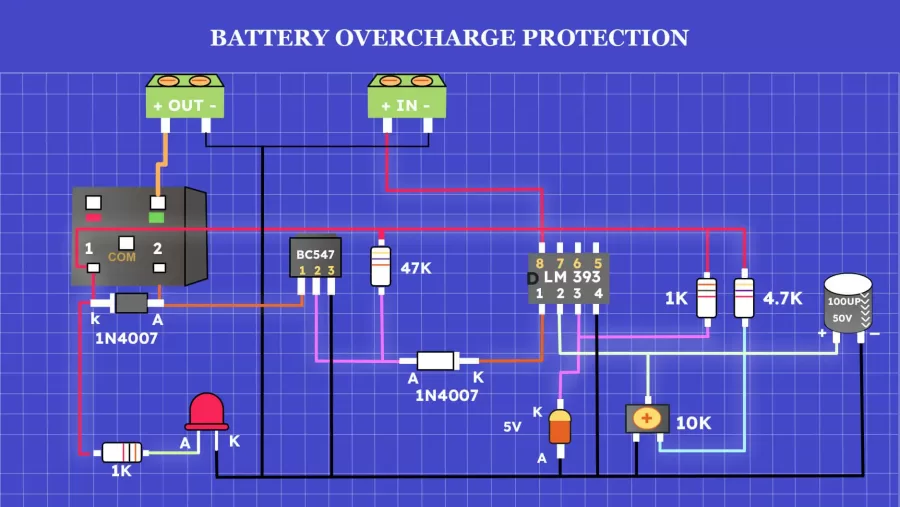The purpose of a 12V battery charger circuit with overcharge protection is to prevent over-discharge, which can harm batteries and endanger public safety. Nowadays, batteries are essential for automobiles and portable gadgets. It’s important to make the batteries last for a long time and reliability. We will offer advice on avoiding overcharge and examine the operation of these circuits in this blog.
What Is a 12V Battery Charger Circuit With Overcharge Protection?
A 12V battery charging circuit with overcharge protection is a system that regulates the charging process of a 12V battery to prevent overcharge. The overcharge protection feature prevents damage and overheating by stopping the battery from over-discharging. This circuit helps to maintain the health of the battery and prolong the battery’s life.
The basic schematic of a 12v battery overcharge protection circuit is as follows:
- AC Input: Connects to the wall outlet for power supply.
- Transformer: Step down the AC voltage to the desired level. It usually transforms 220V or 110V AC to 12V AC.
- Bridge Rectifier: Converts the AC voltage to DC voltage by rectifying it.
- Capacitor: Smooth the rectified DC voltage by reducing ripple.
- Voltage Regulator: Regulates the DC voltage to a constant 12V output.
- Resistor: Limits the charging current to a safe value.
- Transistor: Acts as a switch to control the charging current flow.
- Zener Diode: Provides overcharge protection by regulating the voltage and preventing it from exceeding a certain threshold.
- LED Indicator: Indicates the charging status or battery full condition.
- Battery: Connects to the circuit for charging.
When the circuit is powered, the transformer steps down the AC voltage and the rectifier converts it to DC voltage. After that, the regulated voltage is fed to the battery through the current-limiting resistor and transistor.
When the battery is charged, the voltage is across, and it starts to increase. When the voltage reaches a predetermined level, the zener diode begins conducting. This triggers the transistor to turn off, which stops the flow of current to the battery, preventing over-discharge.
Connect an LED indicator in parallel with the battery to show charging status or signal when the battery is fully charged.
It is crucial to note that this is a basic design, and there may be extra components or alterations based on individual requirements and desired features.

How do You Charge A 12V Battery With A Power Supply?
Before we begin, it is important to make sure that the power supply has the correct voltage and current rating needed to charge 12V batteries to prevent over-discharge. Next, determine the battery’s charging requirements, including the recommended voltage and current limits. You can usually find this information on the battery label or in the datasheet.
When connecting the power supply, connect the positive (+) output of the power supply to the positive terminal of the battery and the negative (-) output to the negative terminal of the battery. It is also necessary to double-check and make sure the polarity is correct to prevent damage. Then adjust the output voltage of the power supply to a level suitable for the battery. It should match the recommended voltage for charging 12V batteries. Avoid exceeding the recommended voltage as this will result in over-discharge and damage to the battery.
Limit the output current of the power supply to the recommended charging current specified by the battery manufacturer. This helps prevent excessive current flow, which can cause overheating or damage to the battery. Some power supplies have adjustable current limits, while others may require an external current limit circuit.
Battery voltage and current should be closely monitored during the charging process. A multimeter or battery charger with monitoring capabilities can help track the progress of the battery charge. Watch for overheating or abnormalities and stop charging if any problems occur. The environment where you are charging can also have an effect. Charging a battery generates heat and sometimes releases potentially flammable gases. So make sure the charging area is well-ventilated to dissipate heat and prevent harmful gases from building up.
Remember, it is always recommended to follow the specific instructions provided by the battery manufacturer to accurately and safely charge the battery.
How to Stop A 12V Battery from Over-discharge?
The most common and effective way to prevent over-discharge of 12V batteries is to use an auto battery charger with overcharge protection. This auto charger senses the state of charge of the battery automatically adjusts the charging current and uses a voltage regulator. The voltage regulator limits the voltage applied to the battery and prevents the battery from being overcharged.
If it is a marine battery or some other battery that is used less frequently, a float charger can be used. It is a device that charges the battery until it reaches its maximum voltage and then maintains a lower charging voltage to prevent over-discharge. To regulate the charging current and voltage from solar panels or other power sources, you can install a charge controller. It monitors the battery’s state of charge and adjusts the charging process to prevent over-discharge.
Using a manual charger is a bit trickier because you must monitor the battery voltage with a voltmeter to know when it’s fully charged. This method requires you to actively supervise the charging process and disconnect the charger manually once the battery reaches the desired charge level. Properly charging a 12V 100Ah LiFePO4 battery with an overcharge protection circuit is critical for its longevity and safety.
Conclusion
Understanding the operating principles of such circuits and following suitable charging procedures will help you ensure your battery’s best performance and longevity. Always follow the battery manufacturer’s instructions and use the dedicated charger to avoid overcharging and optimize the capability of your custom lithium ion battery packs. If you have questions about lithium battery charging, contact us for expert guidance.


